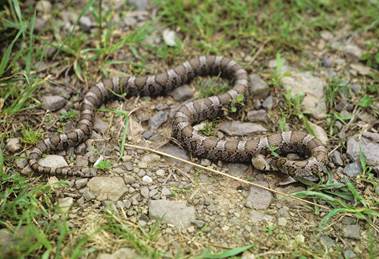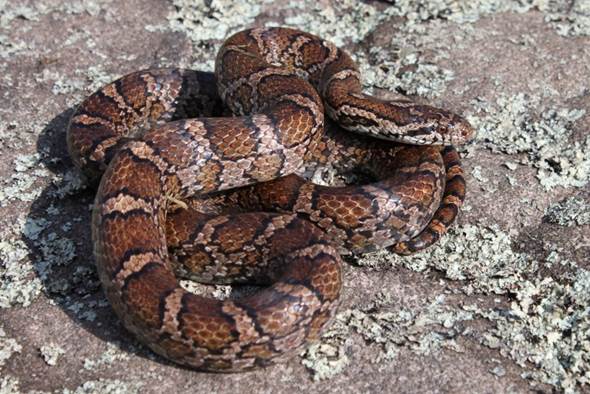If I had my way, we’d sleep every night all wrapped around each other like hibernating rattlesnakes. William S. Burrourghs.
Lampropeltis – Greek lampros meaning radiant, and pelta meaning small shields. Triangulum is derived from the Latin triangulus meaning “having three angles”.
Other common names include chin snake, chicken snake, cow-sucker, milk sucker, and thunder-and-lightening snake. They are also known as checkered adder for their behavior of coiling up when threatened and shaking their tail, often in the dry leaves – feigning a rattlesnake. They have quite the extensive range from Ontario and southern CA through New England down to Florida, west to Utah and south into Mexico.
Milksnakes are among the world’s most widely distributed snakes. Their coloration is quite variable with tan to reddish-brown oval blotches outlined in black along the back and one or two rows of smaller blotches along the sides of the body. The belly has a pattern of black and white checks. Their coloration seems to vary depending upon what other types of snakes live in the area. If there is a sympatric (overlapping range) species with similar coloration milksnake coloration is increasingly dissimilar. There are about 25 subspecies of milksnake but many are understudied and may not warrant a subspecies classification while others may be separate species. So, if you are looking for a good Masters or PhD study, here you go.
I find they can be identified quickly by the Y or V light colored pattern on the back of their head. And once you have the visual pattern down, they look nothing like a copperhead so there is no reason to be shy about picking them up. They are generally calm if you are – this, and their pretty coloration makes them popular as pets. Average length is 24-36 in with a record of 52 in. It is a secretive snake that is often found beneath rock, logs, stumps, and boards. It will eat smaller snakes, lizards, mice, but will also take earthworms, insects, and small frogs. A study in the George Washington National Forest in VA found that their diet consisted of 42% mice, 26% snakes, 16% songbirds and eggs, 11% insects, and 5% shrews.
In turn, milksnakes are preyed upon by opossums, skunks, and raccoons. Milksnakes are constrictors. They catch their prey with their mouth and then quickly wrap their body around the victim to suffocate it and swallow it whole. Because they are often found in and around barns, where rodents live, the myth grew that they crept into cow stalls to suck on their utters for a meal. Not true. The oldest known milksnake lived to 21 years, 4 months, and 18 days. T
his species is oviparous – they are egg layers. Mating takes place in the spring and in June or July females lay 4-12 eggs in rotting wood or beneath rocks and logs. Eggs hatch in 2 – 2.5 months and the youngsters are 3-8 inches long.
When I was in graduate school in western MD we would often go out in the woods because it was cheap entertainment and well, we liked it. One piece of ground I liked to go back to was owned by The Nature Conservancy – an old farm and forest parcel in the Allegheny Mountains not far from my house. The falling apart barn was a good place to snake hunt and it was a good day to find a milksnake like this one – photographed at the barn site. Just one of life’s simple pleasures.

